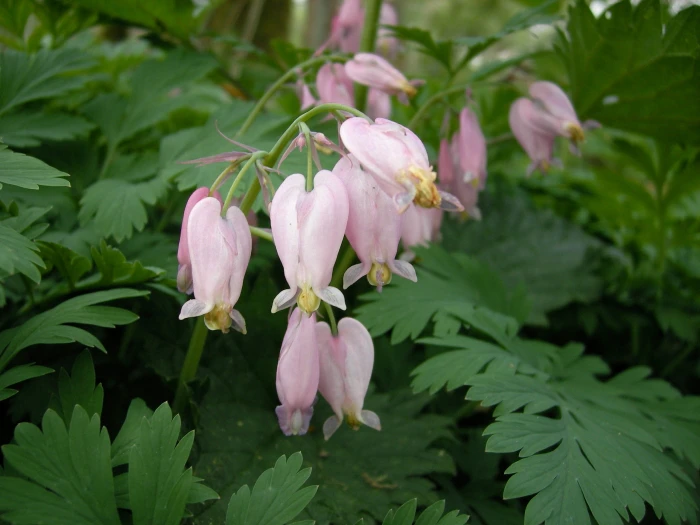Pacific Bleeding Heart
(Dicentra formosa)
Pacific Bleeding Heart (Dicentra formosa)
/
/

Danny Steven S.
CC BY-SA 3.0
Image By:
Danny Steven S.
Recorded By:
Copyright:
CC BY-SA 3.0
Copyright Notice:
Photo by: Danny Steven S. | License Type: CC BY-SA 3.0 | License URL: https://creativecommons.org/licenses/by-sa/3.0 | Uploader: Danny S. | Publisher: Wikimedia Commons | Title: Dicentra_formosa_by_Danny_S._-_001.JPG | Notes: User created page with UploadWizard |











































































Estimated Native Range
Climate Requirements for Bellevue, Washington
| This Plant | Your Site | Plant Suitability for Your Location | ||
|---|---|---|---|---|
| • Precipitation | 3" - 149" | 45" | Aquatic | Aquatic |
| • High Temp. | 58°F - 108°F | 76°F | Your summer temperatures are normal for this plant. | Excellent |
| • Low Temp. | 3°F - 44°F | 34°F | Your winter temperatures are normal for this plant | Excellent |
This plant should grow well at your location with about N inches per year (Y minutes per month) of irrigation.
Summary
Dicentra formosa, commonly known as Pacific Bleeding Heart, is a deciduous perennial herb native to moist woodlands, forests, and streambanks from California to British Columbia, including coastal and subalpine zones. It typically forms clumps up to 18 inches tall and wide, with deeply lobed, fern-like leaves that create a delicate texture in the garden. The flowers are heart-shaped and come in shades of pink, red, or white, hanging in clusters from arching stems above the foliage from mid-spring to autumn, with a peak in spring. After the main flowering period, plants may go dormant in summer, especially in hotter regions, but can re-emerge and bloom again in the fall if conditions are favorable.
Pacific Bleeding Heart is valued for its charming flowers and its ability to thrive in shady conditions, making it an excellent choice for woodland gardens, shaded borders, and naturalized areas. It is also utilized for its low water requirements once established, making it suitable for drought-tolerant plantings. While it prefers part shade, it can tolerate full sun in cooler climates if the soil remains moist. It is adaptable to a range of soil types, provided they have good drainage. Gardeners should be aware that although it is not typically prone to serious pest or disease problems, slugs and snails can sometimes damage the foliage. Additionally, it can self-seed prolifically under ideal conditions, which may require management in some gardens.CC BY-SA 4.0
Pacific Bleeding Heart is valued for its charming flowers and its ability to thrive in shady conditions, making it an excellent choice for woodland gardens, shaded borders, and naturalized areas. It is also utilized for its low water requirements once established, making it suitable for drought-tolerant plantings. While it prefers part shade, it can tolerate full sun in cooler climates if the soil remains moist. It is adaptable to a range of soil types, provided they have good drainage. Gardeners should be aware that although it is not typically prone to serious pest or disease problems, slugs and snails can sometimes damage the foliage. Additionally, it can self-seed prolifically under ideal conditions, which may require management in some gardens.CC BY-SA 4.0
Plant Description
- Plant Type: Herb
- Height: 0.8-1.6 feet
- Width: 1-2 feet
- Growth Rate: Rapid
- Flower Color: Pink, Purple, White
- Flowering Season: Spring, Summer
- Leaf Retention: Deciduous
Growth Requirements
- Sun: Part Shade
- Water: Medium
- Drainage: Fast, Medium, Slow
Common Uses
Bank Stabilization, Bee Garden, Bird Garden, Border Plant, Butterfly Garden, Deer Resistant, Drought Tolerant, Erosion Control, Hummingbird Garden, Low Maintenance, Rabbit Resistant, Rock Garden, Showy Flowers
Natural Habitat
Moist woodlands, forests, and streambanks from California to British Columbia, including coastal and subalpine zones
Other Names
Common Names: Pacific Bleeding-Heart, Western Bleeding Heart, Wild Bleeding Heart, Småhjerte, Dicentre À Belles Fleurs, Dielytra À Belle Fleurs, Gebroken Hartje, Fänrikshjärta
Scientific Names: Dicentra formosa, Corydalis formosa, Dielytra saccata, Dicentra formosa var. formosa, Dielytra formosa
GBIF Accepted Name: Dicentra formosa (Andrews) Walp.